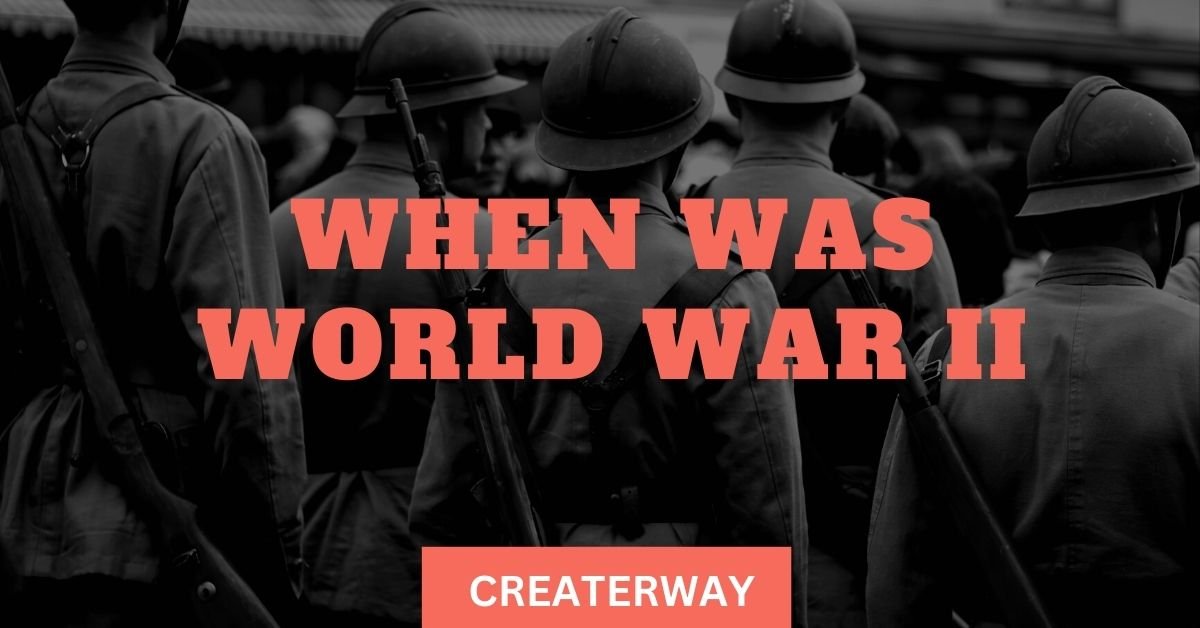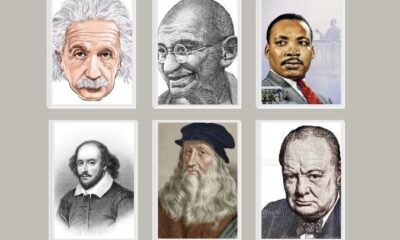EDUCATION
WHEN WAS WORLD WAR II

After World War I. The Treaty of Versailles, designed to bring lasting peace, left Europe in a fragile equilibrium. The punitive measures imposed on Germany sowed the seeds of discontent. On the horizon, the rise of totalitarian regimes threatened to tip the balance.

1. The Rise of Totalitarianism:
A political system characterized by extreme government control over all aspects of public and private life rose to prominence in the early 20th century. It emerged as a response to the socio-political upheaval of the time, driven by factors such as economic instability, social dislocation, and disillusionment with traditional political systems.
Key elements of the rise of totalitarianism:
- World War I and Its Aftermath: The devastation of World War I left many European nations in ruins. This turmoil provided fertile ground for radical ideologies to take root.
- The Russian Revolution: The Bolshevik Revolution of 1917 in Russia, led by Vladimir Lenin, established a communist regime. It became an early example of a totalitarian state, with the Communist Party asserting absolute control over every facet of society.
- Adolf Hitler and Nazi Germany: In the 1930s, Adolf Hitler and the Nazi Party came to power in Germany. Hitler’s totalitarian regime, marked by aggressive expansionism, anti-Semitism, and fascist ideology, led to the horrors of World War II and the Holocaust.
- Mussolini’s Italy: Benito Mussolini’s fascist regime in Italy, which began in the 1920s, emphasized authoritarian rule, nationalism, and militarism.
- Imperial Japan: Japan’s military expansion in the early 20th century marked another form of totalitarianism. The Japanese government, controlled by the military, pursued aggressive territorial expansion in Asia.
Characteristics of totalitarianism include:
- Single-Party Rule: Totalitarian states are typically governed by a single political party, monopolizing power and suppressing opposition.
- Censorship and Propaganda: The control of information is paramount. Censorship and propaganda are used to shape public opinion and eliminate dissent.
- Suppression of Dissent: Totalitarian regimes employ state police and secret services to suppress any opposition, often resorting to violence and persecution.
- Personality Cults: Leaders in totalitarian states often cultivate personality cults to maintain control and loyalty.
- Economic Control: The state typically controls the economy by directing resources and labor.
- Militarism: Many totalitarian states, including Nazi Germany and Imperial Japan, embraced militarism and expansionism as core ideologies.
2. The Global Stage is Set
As the 1930s unfolded, the world stood on the precipice of an explosive conflict. The seeds of war had been sown in the aftermath of World War I, and a volatile mix of territorial ambitions, ideological fervor, and geopolitical tensions was propelling the international community towards a second world war. The global stage was set for a conflict reshaping history in this critical period.
Expansionism and Aggression
One of the key elements in setting the global stage for World War II was the expansionism and aggression of several major powers:
- Japan’s Expansion in Asia: In the 1930s, Japan embarked on a campaign of territorial expansion in Asia. The invasion of Manchuria in 1931 marked the beginning of this aggressive stance. It was followed by Japan’s withdrawal from the League of Nations in 1933, signaling its growing isolation from the international community.
- Hitler’s Ambitions in Europe: Adolf Hitler’s territorial expansion ambitions were no secret. In 1936, he remilitarized the Rhineland, violating the Treaty of Versailles. This provocative move went unchallenged by the Western democracies, emboldening Hitler.
- Annexation of Austria: In 1938, Hitler annexed Austria, a move known as the Anschluss. Again, the international community’s response was muted, further encouraging the Nazi regime.
- The Sudetenland Crisis: The Munich Agreement of 1938 allowed Hitler to annex the Sudetenland, a German-speaking region of Czechoslovakia. This policy of appeasement, in which Britain and France acquiesced to Hitler’s demands in exchange for a promise of no further expansion, did little to prevent future aggression.
The Munich Agreement
The Munich Agreement was a critical juncture before World War II. The diplomatic negotiations in Munich, Germany, in September 1938 resulted in the Western powers agreeing to Hitler’s territorial demands, sacrificing Czechoslovakia in the name of peace. It was a moment of short-sighted diplomacy, as the pact failed to prevent further aggression by Hitler. Winston Churchill, a staunch opponent of appeasement, later referred to the Munich Agreement as “a total and unmitigated defeat.”
The Munich Agreement had far-reaching consequences. It encouraged Hitler and demonstrated the limitations of diplomacy when faced with aggressive expansionist regimes. It marked a clear failure of the policy of appeasement, which had been pursued in the hope of avoiding another large-scale conflict.
3. The Outbreak of War
The fateful day, September 1, 1939, marked the outbreak of World War II, a conflict that would engulf the world in a maelstrom of violence, suffering, and unprecedented change. This pivotal moment was characterized by the invasion of Poland by Nazi Germany, a move that reverberated across the globe and signaled the beginning of hostilities in Europe.
Early Morning in Poland
On that ominous morning, the skies over Poland were still dimly lit as the first German bombs fell on the city of Wieluń. It was a terrifying and tragic commencement to a war brewing for years. The attack on Poland culminated in Adolf Hitler’s aggressive expansionist policies, which the international community tolerated and appeased for too long.
Blitzkrieg and Lightning War
What followed was a lightning-fast campaign known as the “Blitzkrieg” or “lightning war.” German forces, equipped with modern tanks and mechanized infantry, unleashed a devastating assault on Poland. The Polish army, while valiantly resisting, was ill-equipped to counter this new form of warfare.
German forces advanced rapidly, employing tactics of encirclement and aerial bombardment. Cities, towns, and villages were subjected to relentless bombing while the Polish people endured the horrors of war’s early days.
International Response
As the news of the invasion spread, the international community faced a grim reality. The policy of appeasement had failed, and the world was once again plunged into the chaos of war. Within days, Britain and France issued ultimatums to Germany, demanding the withdrawal of its forces from Poland. When these demands went unanswered, both nations declared war on Germany on September 3, 1939.
The Domino Effect
The invasion of Poland triggered a domino effect. Within weeks, the Soviet Union, under Joseph Stalin, also invaded Poland from the east as part of the Molotov-Ribbentrop Pact, a non-aggression agreement signed with Nazi Germany. This double invasion effectively partitioned Poland between the two totalitarian powers.
The Tragedy of Poland
Poland, a nation caught in the crossfire of great powers, endured immense suffering. Its cities were bombed, its citizens displaced, and its army fought bravely but ultimately faced the overwhelming might of the German war machine. Realizing the dire situation, the Polish government evacuated and regrouped in France, where it continued to resist the German occupation.
4. The Global Conflict Unfolds
World War II, a truly global conflict, unfurled with unprecedented fury and devastation, touching nearly every corner of the globe. The conflict engulfed nations and territories, leaving a profound mark on history that continues to shape today’s world.
The Pacific Theater
Japan’s audacious attack on Pearl Harbor in the Pacific Theater in December 1941 pulled the United States into the war. The devastation at Pearl Harbor galvanized the nation, marking a pivotal shift from neutrality to full engagement in the conflict. The Allies embarked on a strategic campaign of “island-hopping,” capturing key strategic islands and bypassing heavily fortified ones. Battles such as Guadalcanal, Iwo Jima, and Okinawa were hard-fought and costly, bringing the Allies closer to the Japanese mainland. The climax of the Pacific War came with the dropping of atomic bombs on Hiroshima and Nagasaki in August 1945, which led to Japan’s unconditional surrender, ending the Pacific conflict.
The Eastern Front:
The Eastern Front witnessed Nazi Germany’s massive invasion of the Soviet Union, known as Operation Barbarossa, in June 1941. Ideological fervor, deep-seated animosities, and extreme weather conditions characterized this brutal conflict. The city of Leningrad endured a devastating 872-day blockade, resulting in immense suffering and loss of life. The Battle of Stalingrad, from August 1942 to February 1943, marked a turning point in the war. This intense urban warfare saw the Soviet forces decisively defeating the German army, altering the momentum of the conflict in favor of the Allies.
A Global Conflict Unfolds
The global conflict of World War II extended beyond these theaters to encompass battles and struggles worldwide. The war left no corner untouched, from North Africa to Western Europe, from the Arctic Circle to the South Pacific. The interconnectedness of these theaters underscored the truly global nature of the conflict. Resources, strategies, and alliances were intricately woven into a war that tested nations’ mettle and individuals’ resilience.
World War II was a chapter in history highlighting human capability’s extremes. It showcased both the horrors of destruction and the heights of bravery and sacrifice. During that era, the world transformed, and the global order experienced an enduring change.
5. The Holocaust
The Holocaust, a devastating chapter of World War II, was a systematic campaign of persecution and extermination orchestrated by Nazi Germany. Driven by deeply rooted anti-Semitic ideologies, the regime implemented discriminatory laws, depriving Jews of their rights and segregating them from society. This persecution evolved into mass atrocities on an unprecedented scale.
The “Final Solution,” conceived in 1942, aimed to annihilate European Jews. Death camps like Auschwitz and Sobibor became instruments of mass murder. The Holocaust claimed around six million Jewish lives, alongside countless others considered “undesirable” by the Nazi regime. The Allied forces bore witness to unspeakable suffering as they unveiled the horrors of the Holocaust during the liberation of concentration camps.
The Nuremberg Trials held Nazi leaders accountable for their crimes.
The Holocaust is a sad reminder of the human capacity for cruelty and the imperative to remember. Museums, memorials, and education ensure the world bears witness to this dark period. The Holocaust is a solemn testament to the necessity of tolerance, human rights, and the collective duty to prevent such atrocities from recurring. It remains an enduring call for a world where “never again” becomes a steadfast commitment.
6. Allied Offensives and Victory
The latter stages of World War II witnessed a series of decisive offensives by the Allied powers, culminating in their ultimate victory over the Axis forces. These offensives marked the turning points that led to the downfall of the Axis and the eventual end of the war.
The North African Campaign
In the North African theater, the Allies launched Operation Torch in November 1942. Led by General Dwight D. Eisenhower, it aimed to liberate North Africa from Axis control. Overcoming fierce opposition from German and Italian forces, the Allies secured victory in the North African campaign by May 1943.
D-Day and the Western Front
Perhaps the most iconic Allied offensives, the D-Day invasion of Normandy on June 6, 1944, marked a watershed moment. Under General Eisenhower’s leadership, Allied forces launched a massive amphibious assault on the beaches of Normandy, France. This operation saw the combined strength of American, British, Canadian, and other forces. Overcoming heavy resistance, they established a crucial foothold on the European mainland. It marked the beginning of the liberation of Western Europe and the eventual defeat of Nazi Germany.
The Pacific Island-Hopping Campaign
In the Pacific theater, the relentless island-hopping campaign took the Allies closer to Japan. Led by General Douglas MacArthur and Admiral Chester Nimitz, this strategy involved bypassing heavily fortified Japanese-held islands and capturing strategically important ones. Key battles at places like Guadalcanal, Iwo Jima, and Okinawa paved the way for the eventual invasion of the Japanese home islands.
The Atomic Bombs and Japan’s Surrender
The use of atomic bombs on the Japanese cities of Hiroshima and Nagasaki in August 1945 forced Japan’s surrender, ending World War II. The devastation of these bombings underscored the immense destructive power of nuclear weapons and prompted Japan to surrender unconditionally.
Victory and the End of World War II
V-E Day, signifying Victory in Europe was proclaimed in May 1945 following Nazi Germany’s unconditional surrender. This Victory over Japan (V-J Day) followed in August 1945 after the bombings of Hiroshima and Nagasaki.
6. The End of World War II
The conclusion of World War II marked a momentous shift in the course of history. The war, ravaging the world for nearly six years, ended through a series of pivotal events and monumental decisions.
Surrender of Germany (V-E Day)
The surrender of Nazi Germany in May 1945 marked the war’s end in Europe. Adolf Hitler’s suicide, the relentless advance of Allied forces, and the Red Army’s capture of Berlin prompted Germany’s unconditional surrender. May 8, 1945, marked the declaration of Victory in Europe (V-E Day), and Europe joyously celebrated the war’s conclusion.
The Pacific Theater and the Atomic Bombs
In the Pacific theater, Japan remained a formidable adversary. However, dropping atomic bombs on Hiroshima and Nagasaki in August 1945 proved to be a turning point. The sheer devastation caused by these bombings prompted Japan’s unconditional surrender. On August 15, 1945, the declaration of Victory over Japan (V-J Day) was made.
The Unveiling of the New World Order
The end of World War II ushered in a new world order.
Founded in 1945, the United Nations encourages global collaboration and prevents potential conflicts. The organization’s formation marked a commitment to diplomacy, human rights, and global peace.
The Legacy of World War II
The legacy of World War II is enduring. It reshaped the world map, altered global power dynamics, and initiated an era of Cold War tensions. The war’s immense human and material costs, along with the horrors of the Holocaust, continue to remind us of the importance of peace, tolerance, and international cooperation.
READ MORE AT CREATERWAY



















